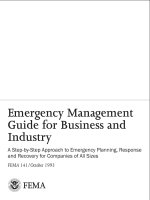Protecting PERSONAL INFORMATION : A Guide for Business pdf
Bạn đang xem bản rút gọn của tài liệu. Xem và tải ngay bản đầy đủ của tài liệu tại đây (3.48 MB, 28 trang )
Protecting
PERSONAL INFORMATION
FEDERAL TRADE COMMISSION
A Guide for Business
FEDERAL TRADE COMMISSION
600 Pennsylvania Avenue, NW
Washington, DC 20580
1–877–FTC–HELP (1–877–382–4357)
c.gov
PROTECTING PERSONAL INFORMATION
A Guide for Business
Most companies keep sensitive personal
information in their files—names, Social
Security numbers, credit card, or other
account data—that identifies customers
or employees.
This information often is necessary
to fill orders, meet payroll, or perform
other necessary business functions.
However, if sensitive data falls into
the wrong hands, it can lead to fraud,
identity theft, or similar harms. Given
the cost of a security breach—losing
your customers’ trust and perhaps even
defending yourself against a lawsuit—
safeguarding personal information is
just plain good business. A sound data security plan is built on 5 key principles:
1. Take stock. Know what personal information
you have in your les and on your computers.
2. Scale down. Keep only what you need for
your business.
3. Lock it. Protect the information that you keep.
4. Pitch it. Properly dispose of what you no
longer need.
5. Plan ahead. Create a plan to respond to security
incidents.
Use the checklists on the following pages to see how your
company’s practices measure up—and where changes
are necessary.
3
1
2
3
4
5
Eective data security starts with assessing what information you have and iden-
tifying who has access to it. Understanding how personal information moves into,
through, and out of your business and who has—or could have—access to it is
essential to assessing security vulnerabilities. You can determine the best ways to
secure the information only aer you’ve traced how it ows.
Inventory all computers, laptops, ash drives, disks, home computers,
and other equipment to nd out where your company stores sensitive data.
Also inventory the information you have by type and location. Your le
cabinets and computer systems are a start, but remember: your business
receives personal information in a number of ways—through websites, from
contractors, from call centers, and the like. What about information saved
on laptops, employees’ home computers, ash drives, and cell phones?
No inventory is complete until you check everywhere sensitive data might
be stored.
Track personal information through your business by talking with your sales
department, information technology sta, human resources oce, accounting
personnel, and outside service providers. Get a complete picture of:
1. TAKE STOCK. Know what personal information you
have in your files and on your computers.
5
TAKE STOCK.
Who sends sen-
sitive personal
information to
your business. Do
you get it from cus-
tomers? Credit card
companies? Banks
or other nancial
institutions? Credit
bureaus? Other
businesses?
How your business
receives personal
information. Does
it come to your
business through
a website? By email? rough the mail? Is it transmitted
through cash registers in stores?
What kind of information you collect at each entry
point. Do you get credit card information online? Does
your accounting department keep information about
customers’ checking accounts?
Where you keep the information you collect at each
entry point. Is it in a central computer database? On
individual laptops? On disks or tapes? In le cabinets? In
branch oces? Do employees have les at home?
Who has—or could have—access to the information.
Which of your employees has permission to access the
information? Could anyone else get a hold of it? What
about vendors who supply and update soware you use
to process credit card transactions? Contractors operat-
ing your call center?
Dierent types of information present varying risks. Pay
particular attention to how you keep personally identifying
information: Social Security numbers, credit card or nancial
information, and other sensitive data. at’s what thieves use
most oen to commit fraud or identity the.
1
SECURITY CHECK
Question:
Are there laws that require my company to
keep sensitive data secure?
Answer:
Yes. While you’re taking stock of the data in
your files, take stock of the law, too. Statutes
like the Gramm-Leach-Bliley Act, the Fair
Credit Reporting Act, and the Federal Trade
Commission Act may require you to provide
reasonable security for sensitive information.
To find out more, visit www.ftc.gov/privacy.
2. SCALE DOWN. Keep only what you need for your
business.
If you don’t have a legitimate business need for sensitive personally identifying
information, don’t keep it. In fact, don’t even collect it. If you have a legitimate
business need for the information, keep it only as long as it’s necessary.
Use Social Security numbers only for required and lawful purposes—
like reporting employee taxes. Don’t use Social Security numbers
unnecessarily—for example, as an employee or customer identication
number, or because you’ve always done it.
7
2
SCALE DOWN.
2
Don’t keep customer credit card information unless
you have a business need for it. For example, don’t
retain the account number and expiration date
unless you have an essential business need to do so.
Keeping this information—or keeping it longer than
necessary—raises the risk that the information could
be used to commit fraud or identity the.
Check the default settings on your soware that reads
customers’ credit card numbers and processes the
transactions. Sometimes it’s preset to keep information
permanently. Change the default setting to make sure
you’re not inadvertently keeping information you don’t
need.
If you must keep information for business reasons
or to comply with the law, develop a written records
retention policy to identify what information must be
kept, how to secure it, how long to keep it, and how to
dispose of it securely when you no longer need it.
SECURITY CHECK
Question:
We like to have accurate information about our customers, so
we usually create a permanent file about all aspects of their
transactions, including the information we collected from the
magnetic stripe on their credit cards. Could this practice put their
information at risk?
Answer:
Yes. Keep sensitive data in your system only as long as you have a
business reason to have it. Once that business need is over, properly
dispose of it. If it’s not in your system, it can’t be stolen by hackers.
It’s as simple as that.
3. LOCK IT. Protect the information that you keep.
What’s the best way to protect the sensitive personally identifying information
you need to keep? It depends on the kind of information and how it’s stored.
e most eective data security plans deal with four key elements: physical
security, electronic security, employee training, and the security practices of
contractors and service providers.
PHYSICAL SECURITY
Many data compromises happen the old-fashioned way—through lost or stolen
paper documents. Oen, the best defense is a locked door or an alert employee.
Store paper documents or les, as well as CDs, oppy disks, zip drives,
tapes, and backups containing personally identiable information in a
locked room or in a locked le cabinet. Limit access to employees with a
legitimate business need. Control who has a key, and the number of keys.
9
LOCK IT.
Require that les containing personally identiable
information be kept in locked le cabinets except when
an employee is working on the le. Remind employees
not to leave sensitive papers out on their desks when
they are away from their workstations.
Require employees to put les away, log o their
computers, and lock their le cabinets and oce doors
at the end of the day.
Implement appropriate access controls for your
building. Tell employees what to do and whom to call if
they see an unfamiliar person on the premises.
If you maintain osite storage facilities, limit employee
access to those with a legitimate business need. Know if
and when someone accesses the storage site.
If you ship sensitive information using outside carriers
or contractors, encrypt the information and keep an
inventory of the information being shipped. Also use
an overnight shipping service that will allow you to
track the delivery of your information.
ELECTRONIC SECURITY
Computer security isn’t just the realm of your IT sta.
Make it your business to understand the vulnerabilities of
your computer system, and follow the advice of experts in
the eld.
General Network Security
Identify the computers or servers where sensitive
personal information is stored.
Identify all connections to the computers where
you store sensitive information. ese may include
the Internet, electronic cash registers, computers
at your branch oces, computers used by service
providers to support your network, and wireless
devices like inventory scanners or cell phones.
3
Assess the vulnerability of each connection to commonly known or
reasonably foreseeable attacks. Depending on your circumstances,
appropriate assessments may range from having a knowledgeable
employee run o-the-shelf security soware to having an independent
professional conduct a full-scale security audit.
Don’t store sensitive consumer data on any computer with an Internet
connection unless it’s essential for conducting your business.
Encrypt sensitive information that you send to third parties over
public networks (like the Internet), and consider encrypting sensitive
information that is stored on your computer network or on disks
or portable storage devices used by your employees. Consider also
encrypting email transmissions within your business if they contain
personally identifying information.
Regularly run up-to-date anti-virus and anti-spyware programs on
individual computers and on servers on your network.
Check expert websites (such as www.sans.org) and your soware
vendors’ websites regularly for alerts about new vulnerabilities, and
implement policies for installing vendor-approved patches to correct
problems.
Scan computers on your network to identify and prole the operating
system and open network services. If you nd services that you
don’t need, disable them to prevent hacks or other potential security
problems. For example, if email service or an Internet connection is
not necessary on a certain computer, consider closing the ports to those
services on that computer to prevent unauthorized access to
that machine.
When you receive or transmit credit card information or other sensitive
nancial data, use Secure Sockets Layer (SSL) or another secure
connection that protects the information in transit.
11
Pay particular attention to the security of your
web applications—the soware used to give
information to visitors to your website and to
retrieve information from them. Web applications
may be particularly vulnerable to a variety of
hack attacks. In one variation called an “injection
attack,” a hacker inserts malicious commands
into what looks like a legitimate request for
information. Once in your system, hackers transfer
sensitive information from your network to their
computers. Relatively simple defenses against these
attacks are available from a variety
of sources.
LOCK IT.
3
SECURITY CHECK
Question:
We encrypt financial data customers submit on our website.
But once we receive it, we decrypt it and email it over the Internet
to our branch offices in regular text. Is there a safer practice?
Answer:
Yes. Regular email is not a secure method for sending sensitive data.
The better practice is to encrypt any transmission that contains
information that could be used by fraudsters or ID thieves.
Password Management
Control access to sensitive information by requiring that employees use
“strong” passwords. Tech security experts say the longer the password,
the better. Because simple passwords—like common dictionary
words—can be guessed easily, insist that employees choose passwords
with a mix of letters, numbers, and characters. Require an employee’s
user name and password to be dierent, and require frequent changes
in passwords.
Explain to employees why it’s against company policy to share their
passwords or post them near their workstations.
Use password-activated screen savers to lock employee computers
aer a period of inactivity.
Lock out users who don’t enter the correct password within a
designated number of log-on attempts.
SECURITY CHECK
Question:
Our account staff needs access to our database of customer financial
information. To make it easier to remember, we just use our company
name as the password. Could that create a security problem?
Answer:
Yes. Hackers will first try words like “password,” your company name,
the software’s default password, and other easy-to-guess choices.
They’ll also use programs that run through common English words and
dates. To make it harder for them to crack your system, select strong
passwords—the longer, the better—that use a combination of letters,
symbols, and numbers. And change passwords often.
13
Warn employees about possible calls from identity
thieves attempting to deceive them into giving
out their passwords by impersonating members
of your IT sta. Let employees know that calls like
this are always fraudulent, and that no one should
be asking them to reveal their passwords.
When installing new soware, immediately change
vendor-supplied default passwords to a more
secure strong password.
Caution employees against transmitting sensitive
personally identifying data—Social Security
numbers, passwords, account information—
via email. Unencrypted email is not a secure way to
transmit any information.
Laptop Security
Restrict the use of laptops to those employees who
need them to perform their jobs.
Assess whether sensitive information really needs
to be stored on a laptop. If not, delete it with a
“wiping” program that overwrites data on the
laptop. Deleting les using standard keyboard
commands isn’t sucient because data may remain
on the laptop’s hard drive. Wiping programs are
available at most oce supply stores.
Require employees to store laptops in a secure
place. Even when laptops are in use, consider using
cords and locks to secure laptops to employees’
desks.
LOCK IT.
3
Consider allowing laptop users only to access sensitive information,
but not to store the information on their laptops. Under this approach,
the information is stored on a secure central computer and the laptops
function as terminals that display information from the central
computer, but do not store it. e information could be further
protected by requiring the use of a token, “smart card,” thumb print, or
other biometric—as well as a password—to access the central computer.
If a laptop contains sensitive data, encrypt it and congure it so users
can’t download any soware or change the security settings without
approval from your IT specialists. Consider adding an “auto-destroy”
function so that data on a computer that is reported stolen will be de-
stroyed when the thief uses it to try to get on the Internet.
Train employees to be mindful of security when they’re on the road.
ey should never leave a laptop visible in a car, at a hotel luggage
stand, or packed in checked luggage unless directed to by airport
security. If someone must leave a laptop in a car, it should be locked in a
trunk. Everyone who goes through airport security should keep an eye
on their laptop as it goes on the belt.
Firewalls
Use a rewall to protect your computer from hacker attacks while it is
connected to the Internet. A rewall is soware or hardware designed
to block hackers from accessing your computer. A properly congured
rewall makes it tougher for hackers to locate your computer and get
into your programs and les.
Determine whether you should install a “border” rewall where
your network connects to the Internet. A border rewall separates
your network from the Internet and may prevent an attacker from
gaining access to a computer on the network where you store sensitive
information. Set “access controls”—settings that determine who gets
through the rewall and what they will be allowed to see—to allow
only trusted employees with a legitimate business need to access the
network. Since the protection a rewall provides is only as eective as
its access controls, review them periodically.
If some computers on your network store sensitive information
while others do not, consider using additional rewalls to protect the
computers with sensitive information.
15
LOCK IT.
3
Wireless and Remote Access
Determine if you use wireless devices like
inventory scanners or cell phones to connect to
your computer network or to transmit sensitive
information.
If you do, consider limiting who can use a wireless
connection to access your computer network. You
can make it harder for an intruder to access the
network by limiting the wireless devices that can
connect to your network.
Better still, consider encryption to make it more
dicult for an intruder to read the content.
Encrypting transmissions from wireless devices to
your computer network may prevent an intruder
from gaining access through a process called
“spoong”—impersonating one of your computers
to get access to your network.
Consider using encryption if you allow remote
access to your computer network by employees
or by service providers, such as companies that
troubleshoot and update soware you use to
process credit card purchases.
Detecting Breaches
To detect network breaches when they occur,
consider using an intrusion detection system.
To be eective, it must be updated frequently to
address new types of hacking.
Maintain central log les of security-related
information to monitor activity on your network
so that you can spot and respond to attacks.
If there is an attack on your network, the log
will provide information that can identify the
computers that have been compromised.
Monitor incoming trac for signs that someone is trying to hack in.
Keep an eye out for activity from new users, multiple log-in attempts
from unknown users or computers, and higher-than-average trac at
unusual times of the day.
Monitor outgoing trac for signs of a data breach. Watch for
unexpectedly large amounts of data being transmitted from your
system to an unknown user. If large amounts of information are
being transmitted from your network, investigate to make sure the
transmission is authorized.
Have in place and implement a breach response plan. See pages 22–23
for more information.
EMPLOYEE TRAINING
Your data security plan may look great on paper, but it’s only as strong as the
employees who implement it. Take time to explain the rules to your sta, and
train them to spot security vulnerabilities. Periodic training emphasizes the
importance you place on meaningful data security practices. A well-trained
workforce is the best defense against identity the and data breaches.
Check references or do background checks before hiring employees who
will have access to sensitive data.
Ask every new employee to sign an agreement to follow your company’s
condentiality and security standards for handling sensitive data. Make
sure they understand that abiding by your company’s data security
plan is an essential part of their duties. Regularly remind employees of
your company’s policy—and any legal requirement—to keep customer
information secure and condential.
Know which employees have access to consumers’ sensitive personally
identifying information. Pay particular attention to data like Social Security
numbers and account numbers. Limit access to personal information to
employees with a “need to know.”
Have a procedure in place for making sure that workers who leave your
employ or transfer to another part of the company no longer have access
to sensitive information. Terminate their passwords, and collect keys and
identication cards as part of the check-out routine.
17
LOCK IT.
3
Create a “culture of security” by implementing
a regular schedule of employee training. Update
employees as you nd out about new risks and
vulnerabilities. Make sure training includes employees
at satellite oces, temporary help, and seasonal
workers. If employees don’t attend, consider blocking
their access to the network.
Train employees to recognize security threats. Tell
them how to report suspicious activity and publicly
reward employees who alert you to vulnerabilities.
SECURITY CHECK
Question:
I’m not really a “tech” type. Are there steps our computer people can
take to protect our system from common hack attacks?
Answer:
Yes. There are relatively simple fixes to protect your computers
from some of the most common vulnerabilities. For example, a
threat called an “SQL injection attack” can give fraudsters access
to sensitive data on your system, but can be thwarted with a simple
change to your computer. Bookmark the websites of groups like the
Open Web Application Security Project, www.owasp.org, or SANS
(SysAdmin, Audit, Network, Security) Institute’s Twenty Most Critical
Internet Security Vulnerabilities, www.sans.org/top20, for up-to-date
information on the latest threats—and fixes. And check with your
software vendors for patches that address new vulnerabilities.
Tell employees about your company policies regarding keeping information
secure and condential. Post reminders in areas where sensitive
information is used or stored, as well as where employees congregate. Make
sure your policies cover employees who telecommute or access sensitive
data from home or an osite location.
Warn employees about phone phishing. Train them to be suspicious of
unknown callers claiming to need account numbers to process an order or
asking for customer or employee contact information. Make it oce policy
to double-check by contacting the company using a phone number you
know is genuine.
Require employees to notify you immediately if there is a potential security
breach, such as a lost or stolen laptop.
Impose disciplinary measures for security policy violations.
For computer security tips, tutorials, and quizzes for everyone on your sta,
visit www.OnGuardOnline.gov.
19
SECURITY PRACTICES OF CONTRACTORS
AND SERVICE PROVIDERS
Your company’s security practices depend on the people
who implement them, including contractors and service
providers.
Before you outsource any of your business functions—
payroll, web hosting, customer call center operations,
data processing, or the like—investigate the company’s
data security practices and compare their standards to
yours. If possible, visit their facilities.
Address security issues for the type of data your service
providers handle in your contract with them.
Insist that your service providers notify you of any
security incidents they experience, even if the incidents
may not have led to an actual compromise of your data.
LOCK IT.
3
4. PITCH IT. Properly dispose of what you no
longer need.
What looks like a sack of trash to you can be a gold mine for an identity thief.
Leaving credit card receipts or papers or CDs with personally identifying
information in a dumpster facilitates fraud and exposes consumers to the risk of
identity the. By properly disposing of sensitive information, you ensure that it
cannot be read or reconstructed.
Implement information disposal practices that are reasonable and
appropriate to prevent unauthorized access to—or use of—personally
identifying information. Reasonable measures for your operation are based
on the sensitivity of the information, the costs and benets of dierent
disposal methods, and changes in technology.
21
PITCH IT.
Eectively dispose of paper records by shredding,
burning, or pulverizing them before discarding.
Make shredders available throughout the workplace,
including next to the photocopier.
When disposing of old computers and portable storage
devices, use wipe utility programs. ey’re inexpensive
and can provide better results by overwriting the entire
hard drive so that the les are no longer recoverable.
Deleting les using the keyboard or mouse commands
usually isn’t sucient because the les may continue
to exist on the computer’s hard drive and could be
retrieved easily.
Make sure employees who work from home follow the
same procedures for disposing of sensitive documents
and old computers and portable storage devices.
If you use consumer credit reports for a business
purpose, you may be subject to the FTC’s Disposal
Rule. For more information, see Disposing of Consumer
Report Information? New Rule Tells How at
www.c.gov/privacy (click on Credit Reporting,
Business Guidance).
4
SECURITY CHECK
Question:
My company collects credit applications from customers. The form
requires them to give us lots of financial information. Once we’re
finished with the applications, we’re careful to throw them away.
Is that sufficient?
Answer:
No. Have a policy in place to ensure that sensitive paperwork is
unreadable before you throw it away. Burn it, shred it, or pulverize it to
make sure identity thieves can’t steal it from your trash.
Taking steps to protect data in your possession can go a long way toward
preventing a security breach. Nevertheless, breaches can happen. Here’s
how you can reduce the impact on your business, your employees, and your
customers:
Have a plan in place to respond to security incidents. Designate a senior
member of your sta to coordinate and implement the response plan.
If a computer is compromised, disconnect it immediately from the Internet.
5. PLAN AHEAD. Create a plan for responding to
security incidents.
23
PLAN AHEAD.
Investigate security incidents immediately and take
steps to close o existing vulnerabilities or threats to
personal information.
Consider whom to notify in the event of an incident,
both inside and outside your organization. You may
need to notify consumers, law enforcement, customers,
credit bureaus, and other businesses that may be
aected by the breach. In addition, many states and
the federal bank regulatory agencies have laws or
guidelines addressing data breaches. Consult your
attorney.
5
SECURITY CHECK
Question:
I own a small business. Aren’t these precautions going to cost me
a mint to implement?
Answer:
No. There’s no one-size-fits-all approach to data security, and
what’s right for you depends on the nature of your business and the
kind of information you collect from your customers. Some of the
most effective security measures—using strong passwords, locking
up sensitive paperwork, training your staff, etc.—will cost you next
to nothing and you’ll find free or low-cost security tools at non-profit
websites dedicated to data security. Furthermore, it’s cheaper in the
long run to invest in better data security than to lose the goodwill
of your customers, defend yourself in legal actions, and face other
possible consequences of a data breach.









